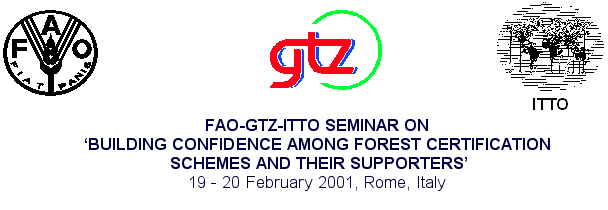



Introduction
The following Moderator's Closing Remarks provide an overview of some of the main points covered in the seminar. While the participants discussed this summary, and the main comments made have been taken into account, it still remains the Closing Remarks of the Moderator. It attempts to provide an indication of the main views and issues. It should not be seen as a text that expresses a consensus view of the participants. It does however provide an indication of the many points made by the participants during the seminar.
The Moderator's Closing Remarks should be read in conjunction with the summaries of the Working Groups.
1. The various stakeholder groups share the view that forest certification can be a useful tool for promoting sustainable forest management (SFM).
2. Reflecting the diversity in the groups present at the seminar, there were varying views on how certification should be developed and, in particular, what constitutes a credible certification system. Areas of both agreement and concern were identified. It is not entirely clear to many stakeholders how some systems function in practice and more information is needed on many aspects.
3. There are also differing views on the comparative advantages of alternative systems. Some stakeholders have firm positions on which particular scheme they support and these positions are closely linked with their values. It is important to recognize similarities and differences that exist in values, goals and interests of stakeholder groups if certification is to be made more effective in moving towards achieving its main objectives. In addition, due attention should be given to possible political implications of how certification is implemented, such as their trade policy effects.
4. There was a concern among some participants that the proliferation of certification schemes is becoming a problem. Others considered that there are benefits in having a variety of schemes. A number of ways of addressing the situation were suggested. Mutual recognition between schemes, or a variation, was seen by many as one solution to the problem of proliferation, while others felt that it was not appropriate.
5. It was clear that the creation of mutual trust is an important first step if there is to be improved dialogue and cooperation between the different certification processes. Experience with collaboration between certification schemes has shown that the creation of mutual trust that is needed to establish practical arrangements is a lengthy process of mutual learning ("the devil is in the details").
6. In addition to arrangements covering certification of the standard of forest management, chain of custody issues are seen as important.
7. In order to provide improved information on the similarities and differences between schemes, further analytical work is needed, including the development of common definitions and indicators. It was suggested that the focus could be more on outcomes than the system characteristics.
8. There exists a growing demand for certified forest products in many major markets, including for tropical timber, which cannot be currently met. Increased supply of certified products would be needed to enable buyers to meet their purchasing commitments on products from sustainably managed forests.
9. Certification could be actively used as a tool for demonstrating the environmental and social credentials of forest products, as similar information is not available for their substitutes in the market.
10. In general, developing countries do not have great difficulty in fully participating in the international dialogue on forest certification. Of more significance, are the practical constraints they face in implementing SFM and certification. These tend to be constantly overlooked.
11. There are particular difficulties in implementing certification in developing country conditions, and considerable resources are required in order to address these. Many issues which are not of significance in developed countries need to receive attention.
12. The national certification schemes of some developing countries are taking pragmatic market-oriented approaches in their cooperation with other schemes and initiatives in order to have access to markets where certified products are in demand. However, since the outcome of these approaches is still uncertain, other options such as mutual recognition are also being considered.
13. Small-scale forest owners and forest communities have particular concerns on how certification of their forests should be carried out while respecting their rights and views, and on how they could share the benefits of certification. The difficulties these groups might face if certification became a requirement for market entry were mentioned.
14. It was suggested that social criteria of certification should incorporate the ILO Core Conventions, and that these could be extended to apply to the entire production process in the forestry sector, not just to the forest management aspects.
15. Despite the variation in views and approaches favoured, the seminar was considered to be a useful exercise, and participants agreed that further face-to-face dialogue is needed among stakeholder groups to build up necessary knowledge in order to develop mutual trust. This would assist the development of common views on how to make progress in resolving the constraints and thus making certification work effectively towards sustainable forest management. Such dialogue is needed both at national and international levels. It should enhance willingness and openness of participants to develop shared goals.
16. The dialogue should address both political and technical aspects, since these can differ between schemes. An important starting point for improving dialogue between stakeholders is recognition of the similarities and differences that exist.
17. Follow-up action to facilitate the dialogue at
international level is needed and organizations such as FAO, GTZ and ITTO should
continue to facilitate this dialogue, since they are able to bring a broad
spectrum of stakeholders together.